 Gilman Studio On-Line Lessons
Gilman Studio On-Line Lessons
Yang Style Long Form
Tai Chi Chuan
This Lesson Contains:
Compression, Torsion and Rebounding and Movement # 10 – Left Brush Knee
Compression, Torsion, and Rebounding
Compression, torsion and rebounding are three of the main ways that we work with energy in Tai Chi, to produce seemingly effortless results. All of these actions are used in our everyday movements, yet when consciously applied to Tai Chi, we can gain a great deal of understanding of how to do the most work with the least output. That is certainly one of the greatest benefits of the study of Tai Chi -learning how to do the most with the least.
Compression requires two or more surfaces. At least one of these surfaces must be moved toward the other for compression to take place. In Tai Chi, we place weight on the feet and compression is the result. The more weight we place on the foot, the more compression. By placing the bodies weight on one foot instead of two, we increase the compression. By jumping or hopping, we can increase compression. By having someone else push his or her weight into us, we can increase compression.
Torsion is twisting or turning. One end is twisted or turned while the other is either held still, or both ends can be twisted or turned but in the opposite directions. In Tai Chi, the feet and legs are rooted and still while the upper torso is twisted or turned. The turning can be done on our own, or a partner usually does it for us.
Rebounding is the result of compression and or torsion being released. One of the major tenets of Tai Chi is the idea of borrowing energy. If we think about the above-mentioned processes, we can easily see the results of our partner or opponent giving us energy in the form of pushing us in some way. If we align ourselves in the proper fashion so that the compression or torsion is grounded into our root, the resulting rebound or release can be much stronger then if we didn’t have the extra energy of our partner.
If we think of the rebounding of a ball, I’m sure this will be quite clear. Drop a basketball from waist level and it will bounce back (rebound), say to your knee. If you drop it from an over the head height, it will rebound higher, say to your waist. If you throw it down to the ground with a great deal of force, it will rebound even higher, say to the top of your head. The difference in all of these actions is the amount of compression that the ball undergoes when it hits the floor. In the case of Tai Chi, it is the amount of force that our opponent uses against us.
Movement # 10 – Left Brush Knee
Brushing the knee is quite a useful movement and is repeated throughout the form. I’m not sure where the name comes from, yet the movement of the left hand, in this case, will look like brushing the knee when the hand passes the left knee at the end. There are many possible applications for this movement. For this one following the previous Stork Spreads Its Wings, I first strike with the left hand edge and follow up with a palm thrust to the side of the head.
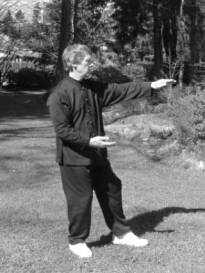
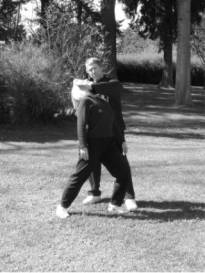 The first part of this movement is the left palm edge strike. The strike is done with the turning of the center to the right in a snapping motion. The right arm pulling down at the same time the left arm is thrust upward in an arcing motion balances this. The form softens and relaxes all this so that the movement is slow and steady like everything else.
The first part of this movement is the left palm edge strike. The strike is done with the turning of the center to the right in a snapping motion. The right arm pulling down at the same time the left arm is thrust upward in an arcing motion balances this. The form softens and relaxes all this so that the movement is slow and steady like everything else.
From the end of Stork, the right hand turns inward and drops to the right hip, palm facing upward. Do not let the elbow get behind the body. At the same time, the left arm makes a soft arc upward to end up palm facing down in front of the left side of the chest. The feet haven’t changed and the torso has only make a slight twist, first left then right. It is very subtle.
Focus on the left palm edge.
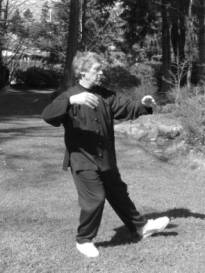
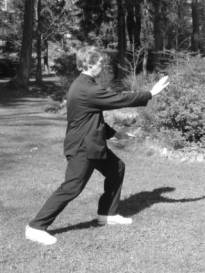 First, the body turns slightly to the right, the left foot steps out slightly to the left of west, the right hand circles up to end up on the right side of the chest, and the left arm has stayed on the left side of the chest and moved to the right as the torso turned.
First, the body turns slightly to the right, the left foot steps out slightly to the left of west, the right hand circles up to end up on the right side of the chest, and the left arm has stayed on the left side of the chest and moved to the right as the torso turned.
When stepping, be sure to just touch down the left heel and do not put any weight on it yet. Do not lean to the right.
Next, shift the weight to the left foot, turning the torso until the nose points to the left knee. The left forearm straightens; pivoting at the elbow, and ending up on the left side of the left thigh, palm facing downward. The right palm has filled and extended out. Be sure to keep the elbows soft and drooping. Let the right palm end up on the right side of the chest.
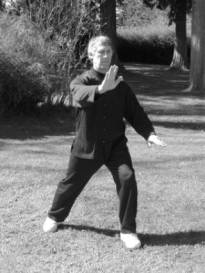
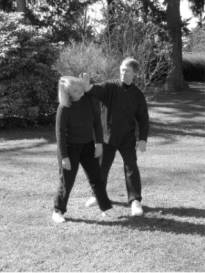 In this application, the right palm delivers a strike to the head of my partner. It could have just as easily delivered a strike to the torso, or pushed, or blocked a counter attack.
In this application, the right palm delivers a strike to the head of my partner. It could have just as easily delivered a strike to the torso, or pushed, or blocked a counter attack.
When striking with the palm, focus the energy in the heel of the hand. You can feel the hard bones close to the surface just above the wrist. Be sure to use plenty of Peng Jin in the fingers to keep them up and out of the way. The forward energy of the thrusting right palm is balanced by the pulling back of the left hand. Do not let the right hand cross to the left of the center line of the chest as that will make the body vulnerable to being closed up by opponent trapping the right arm against the chest.
Focus on the right palm and on pulling back on the left hand.
